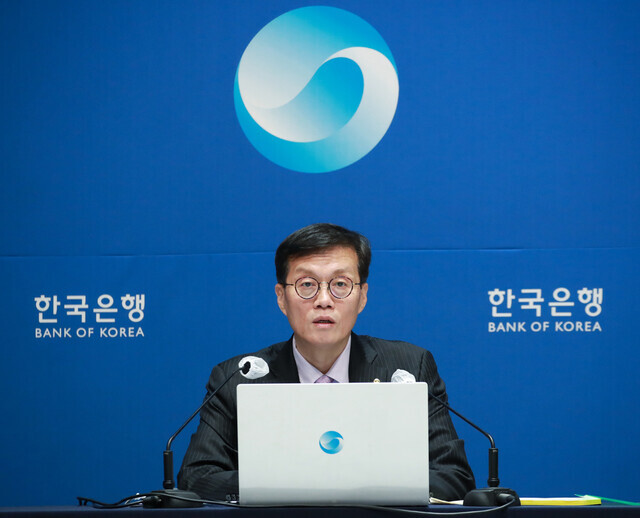hankyoreh
Links to other country sites 다른 나라 사이트 링크
Despite austerity measures, Korea sees highest household debt-to-GDP ratio of major economies in Q1

Although South Koreans’ debt continued to shrink in the first quarter of the year in line with the Bank of Korea’s tight monetary policy, Korea still has the highest household debt relative to GDP of any major economy. It’s also possible that household debt will start increasing again in the second quarter.
According to this month’s “Global Debt Monitor” published by the Institute of International Finance, outstanding household debt at the end of the first quarter amounted to 102.2% of Korea’s nominal yearly GDP. That was the highest percentage of the 33 countries being reviewed, as well as the eurozone as a whole. Other countries with a high level of household debt were Hong Kong (95.1%), Thailand (85.7%) and the UK (81.5%).
Korea remained at the top of the list even though household debt began decreasing in the second half of 2022 after the Bank of Korea raised the benchmark interest rate. In fact, Korea was just one of many countries in which the household debt ratio trended downward as central banks around the world hiked interest rates last year.
Korea’s household debt-to-GDP ratio was down 3.3 percentage points from the previous year and down 0.6 points from three months ago. The global household debt ratio was 62.0%, a year-over-year decline of 1.9 points.
But Korea’s household debt ratio could start climbing again in the second quarter of the year. Figures provided by the Financial Services Commission show that outstanding household loans at the country’s banks rose by 200 billion won over the month of April, the first uptick in the metric since August 2022. The new loans are driven by rebounding real estate prices and the popularity of government-subsidized mortgages.
“We can’t help feeling concerned about the possibility of [household loans] rising again in the medium to long term,” said Rhee Chang-yong, governor of the Bank of Korea, in a press conference on Thursday.
Notably, the debt ratio at Korea’s non-financial corporate sector has continued to rise as well. Outstanding debt at non-financial companies at the end of the first quarter was 118.4% of Korea’s nominal GDP, up 3.1 points year over year. That contrasts with the global debt ratio at non-financial companies, which fell from 97.5% to 96.3%.
Korea ranked fifth on the metric, after Hong Kong (269.0%), China (163.7%), Singapore (126.0%) and Japan (118.7%).
By Lee Jae-yeon, staff reporter
Please direct questions or comments to [english@hani.co.kr]

Editorial・opinion
![[Editorial] Intensifying US-China rivalry means Seoul must address uncertainty with Beijing sooner than later [Editorial] Intensifying US-China rivalry means Seoul must address uncertainty with Beijing sooner than later](https://flexible.img.hani.co.kr/flexible/normal/500/300/imgdb/original/2024/0517/8117159322045222.jpg) [Editorial] Intensifying US-China rivalry means Seoul must address uncertainty with Beijing sooner than later
[Editorial] Intensifying US-China rivalry means Seoul must address uncertainty with Beijing sooner than later![[Column] When ‘fairness’ means hate and violence [Column] When ‘fairness’ means hate and violence](https://flexible.img.hani.co.kr/flexible/normal/500/300/imgdb/original/2024/0516/7417158465908824.jpg) [Column] When ‘fairness’ means hate and violence
[Column] When ‘fairness’ means hate and violence- [Editorial] Yoon must stop abusing authority to shield himself from investigation
- [Column] US troop withdrawal from Korea could be the Acheson Line all over
- [Column] How to win back readers who’ve turned to YouTube for news
- [Column] Welcome to the president’s pity party
- [Editorial] Korea must respond firmly to Japan’s attempt to usurp Line
- [Editorial] Transfers of prosecutors investigating Korea’s first lady send chilling message
- [Column] Will Seoul’s ties with Moscow really recover on their own?
- [Column] Samsung’s ‘lost decade’ and Lee Jae-yong’s mismatched chopsticks
Most viewed articles
- 1For new generation of Chinese artists, discontent is disobedience
- 2[Editorial] Transfers of prosecutors investigating Korea’s first lady send chilling message
- 3[Exclusive] Unearthed memo suggests Gwangju Uprising missing may have been cremated
- 4[Editorial] Intensifying US-China rivalry means Seoul must address uncertainty with Beijing sooner t
- 5S. Korea “monitoring developments” after report of secret Chinese police station in Seoul
- 6N. Korean media upgrades epithet for leader’s daughter from “beloved” to “respected”
- 7Yoon says concern about biased diplomacy is being incited by “communist totalitarian forces”
- 8[Column] US troop withdrawal from Korea could be the Acheson Line all over
- 9Xi, Putin ‘oppose acts of military intimidation’ against N. Korea by US in joint statement
- 1060% of young Koreans see no need to have kids after marriage